
Cercis canadensis, the eastern redbud, is a large deciduous shrub or small tree, native to eastern North America from southern Michigan south to central Mexico, west to New Mexico. Species thrive as far west as California and as far north as southern Ontario. It is the state tree of Oklahoma. The prevalence of the so-called "Columbus strain" has seen the residents of Columbus, Wisconsin, embrace the plant in their city's identity. Known as the "Redbud City," the town hosts "Redbud Day" annually the Saturday before Mother's Day, organizing a variety of themed events to recognize the tree.

The stone pine, botanical name Pinus pinea, also known as the Italian stone pine, Mediterranean stone pine, umbrella pine and parasol pine, is a tree from the pine family (Pinaceae). The tree is native to the Mediterranean region, occurring in Southern Europe and the Levant. The species was introduced into North Africa millennia ago, and is also naturalized in the Canary Islands, South Africa and New South Wales.

Koelreuteria paniculata is a species of flowering plant in the family Sapindaceae, native to China. Naturalized in Korea and Japan since at least the 1200s, it was introduced in Europe in 1747, and to America in 1763, and has become a popular landscape tree worldwide. Common names include goldenrain tree, pride of India, China tree, and the varnish tree.

Paulownia tomentosa, common names princess tree, empress tree, or foxglove-tree, is a deciduous hardwood tree in the family Paulowniaceae, native to central and eastern China and the Korean Peninsula. It is an extremely fast-growing tree with seeds that disperse readily and is considered an invasive exotic species in North America that has undergone naturalisation in large areas of the Eastern US, even though it might be able to successfully get established through seeds only under ideal conditions. P. tomentosa has also been introduced to Western and Central Europe, and is establishing itself as a naturalised species there as well.
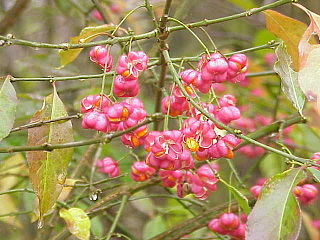
Euonymus europaeus, the spindle, European spindle, or common spindle, is a species of flowering plant in the family Celastraceae, native to much of Europe, where it inhabits the edges of forest, hedges and gentle slopes, tending to thrive on nutrient-rich, chalky and salt-poor soils. It is a deciduous shrub or small tree.
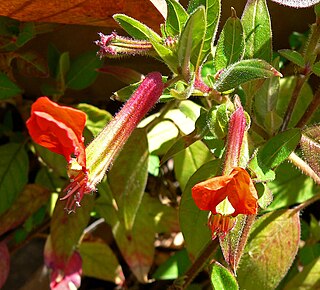
Cuphea is a genus containing about 260 species of annual and perennial flowering plants native to warm temperate to tropical regions of the Americas. The species range from low-growing herbaceous plants to semi-woody shrubs up to 2 m tall. Commonly they are known as cupheas, or, in the case of some species, as cigar plants. The generic name is derived from the Greek word κυφος (kyphos), meaning "bent," "curved," or "humped."

Rhus typhina, the staghorn sumac, is a species of flowering plant in the family Anacardiaceae, native to eastern North America. It is primarily found in southeastern Canada, the northeastern and midwestern United States, and the Appalachian Mountains, but it is widely cultivated as an ornamental throughout the temperate world. It is an invasive species in some parts of the world.

Catalpa speciosa, commonly known as the northern catalpa, hardy catalpa, western catalpa, cigar tree or catawba, is a species of Catalpa native to the midwestern United States.
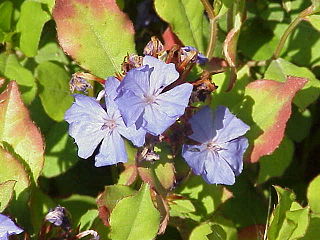
Ceratostigma (;), or leadwort, plumbago, is a genus of eight species of flowering plants in the family Plumbaginaceae, native to warm temperate to tropical regions of Africa and Asia. Common names are shared with the genus Plumbago.

Rhododendron luteum, the yellow azalea or honeysuckle azalea, is a species of flowering plant in the heath family Ericaceae, native to southeastern Europe and southwest Asia. In Europe, it occurs from southern Poland and Austria, south through the Balkans, and east to southern Russia; and in Asia, east to the Caucasus.

Kalmia angustifolia is a flowering shrub in the family Ericaceae, commonly known as sheep laurel. It is distributed in eastern North America from Ontario and Quebec south to Virginia. It grows commonly in dry habitats in the boreal forest, and may become dominant over large areas after fire or logging. Like many plant species of infertile habitats it has evergreen leaves and mycorrhizal associations with fungi. It is also found in drier areas of peat bogs.

Hoheria is a genus of six species of flowering plants in the family Malvaceae. All are endemic to New Zealand. The genus name is a latinization of the Māori language name, houhere. That name, as well as lacebark and ribbonwood, are often used as common names. The name lacebark comes from the lace-like fibrous inner bark layer.
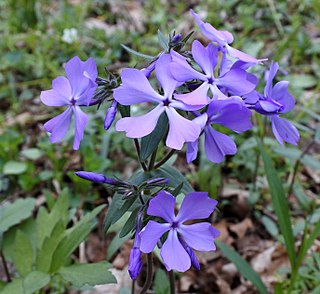
Phlox divaricata, the wild blue phlox, woodland phlox, or wild sweet william, is a species of flowering plant in the family Polemoniaceae, native to forests and fields in eastern North America.

Ligustrum ovalifolium, also known as Korean privet, California privet, garden privet, and oval-leaved privet, is a species of flowering plant in the olive family Oleaceae. The species is native to Japan and Korea.

Plumeria rubra is a deciduous plant species belonging to the genus Plumeria. Originally native to Mexico, Central America, Colombia and Venezuela, it has been widely cultivated in subtropical and tropical climates worldwide and is a popular garden and park plant, as well as being used in temples and cemeteries. It grows as a spreading tree to 7–8 m (23–26 ft) high and wide, and is flushed with fragrant flowers of shades of pink, white and yellow over the summer and autumn.

Spiraea japonica, the Japanese meadowsweet or Japanese spiraea, is a plant in the family Rosaceae.

Erica lusitanica is a European species of flowering plant in the family Ericaceae, known by the common names Portuguese heath and Spanish heath.

Cuphea ignea, the cigar plant, cigar flower, firecracker plant, or Mexican cigar, is a species of flowering plant in the genus Cuphea of the family Lythraceae. It is a tropical, densely branched evergreen subshrub. This species, native to Mexico and the West Indies, produces small, tubular, bright red to orange flowers. Each flower is tipped with a thin white rim and two small purple-black petals. The flowers, which are attractive to hummingbirds and butterflies, resemble lit cigars, hence the name ignea, which is Latin for "fiery". The genus name Cuphea comes from the Greek word kyphos which means curved or humped; this is thought to refer to the shape of the seeds. The leaves are small, elliptical and of a bright green colour. It grows to about 60 cm (24 in).
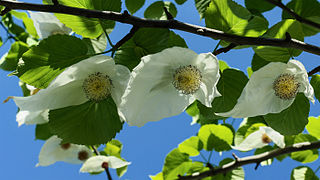
Davidia involucrata, the dove-tree, handkerchief tree, pocket handkerchief tree, or ghost tree, is a medium-sized deciduous tree in the family Nyssaceae. It is the only living species in the genus Davidia. It was previously included with tupelos in the dogwood family, Cornaceae. Fossil species are known extending into the Upper Cretaceous.

Wisteria brachybotrys, the silky wisteria, is a species of flowering plant in the pea family Fabaceae from Japan. Some older references believed it to be of garden origin. It is certainly very widely cultivated in its native Japan, with the white flowered cultivars more widely grown than the pale violet cultivars. It is in fact native to western parts of Honshu and throughout Shikoku and Kyushu, growing in mountain forests and woods from 100 to 900m. It is not at all clear why it is less popular in the west than in Japan.






















